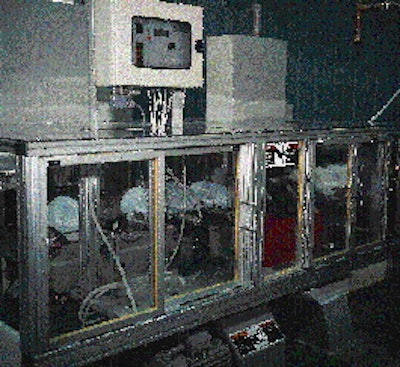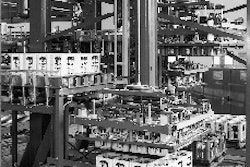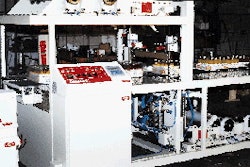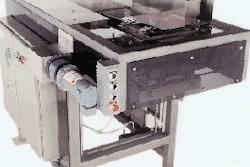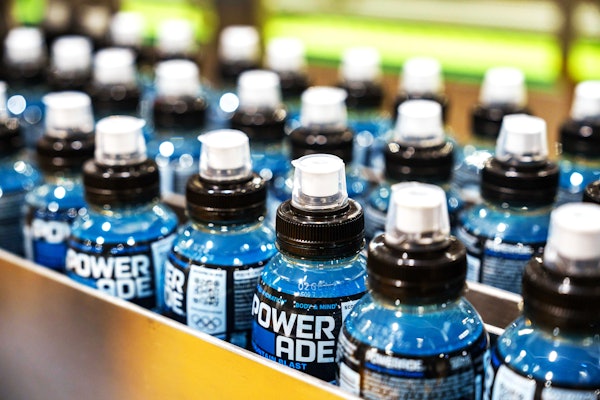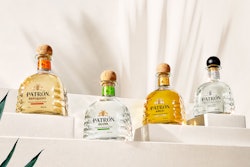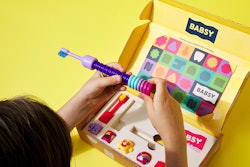The significant freight savings that prompted AquaPenn Spring Water Co. to develop an insourcing relationship with Schmalbach-Lubeca for polyethylene terephthalate bottles also led to AquaPenn's decision to begin making its own 1-gal high-density polyethylene containers. Like their PET cousins, water in HDPE jugs is also sold at retail.
Captive molding began in February, according to Dick Cooper, AquaPenn's director of corporate communications. "Before that, another company made them and we paid for them to be shipped to our plant here in Milesburg. By molding them on-site, we estimate that we're saving at least 10 percent on shipping costs," he says.
Like typical "milk jugs," AquaPenn's 1-gal water containers are extrusion blown, in this case on two Uniloy machines from Johnson Controls' Plastic Machinery Div. (Manchester, MI). The six-head Uniloys operate at cycle times of about 7.5 seconds. Annual production on the two machines is currently estimated at 36 million bottles, says AquaPenn's Lou Rizzo, Jr. Resin is supplied by Paxon Polymer Co. (Baton Rouge, LA).
Pallets containing gaylord quantities of resin are delivered to a blending room within the Milesburg plant. Rizzo says virgin HDPE and post-industrial regrind is used to make the containers. HDPE is extruded through a die at about 350°F. All six parisons on the machine are clamped between mold halves. Molds close, then air is injected into the molds, blowing the plastic against the halves so that the material in each cavity takes on the container shape of the chilled mold. Next, the molds open, with a group of mechanical fingers taking the containers and delivering them onto a cooling bed.
Containers cool in the extruding room's 55°F ambient air as they are conveyed single-file on an incline conveyor. They then make a right-angle turn to a trim station where flashing is cut away from both the finish and bottom areas. A small piece of plastic between the handle and shoulder is also punched out at the trim station. "Temperature in this room is important," Rizzo notes. "By keeping the room cool and maintaining a low dew point, trimming is easier," notes Rizzo. A vacuum system draws the excess flash and sends it back to the extruder for reuse.
After trimming, containers index a few feet to a leak detection system that blows air through the open neck finish. If a leak is detected, the container is dropped into a reject bin below the conveyor. Satisfactory containers proceed through a shrink tunnel where heat is used to anneal them, thus ensuring each is consistent in size. The shrink tunnel is supplied by Ideas In Motion (Grand Rapids, MI).
Storage options
Containers then are conveyed to a large alpine conveyor system, also from Ideas In Motion, that provides up to 23 minutes' worth of storage. This storage provides AquaPenn with options. For example, if containers are needed for filling, they can be palletized and delivered directly to the staging area of the filling line.
If the just-produced containers aren't required immediately on the filling line, they're automatically bagged in low-density polyethylene film. Containers are film-wrapped in groups, with each group forming a layer that's lifted onto a pallet. Film not only holds individual containers, it also helps prevent unwanted material of any kind from getting in the bottle before filling.
Pallets containing wrapped layers of 1-gal jugs are then moved to a storage area until they're needed for filling. At that time, an automatic debagger removes the film from each layer. Both the bagger and debagger are also from Ideas In Motion.
"We've been extremely pleased with every aspect of our HDPE container-making process," Rizzo says. "The Uniloy machines are very productive and allow us to maintain much greater control and quality of the containers compared to having them shipped in. And the entire system from Ideas In Motion eliminates potential labor costs that would otherwise be necessary to handle these containers."
While AquaPenn wouldn't provide specific figures, Dick Cooper does say, "we're saving money in labor compared to when we had these containers shipped to us because they would come to us in bags that we'd have to open and prepare for downstream filling. Now, not only do we avoid having finished bottles shipped to us, we also have a choice of feeding bottles directly from manufacturing to the filling line, or to a storage area."
